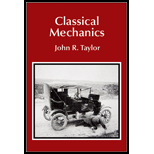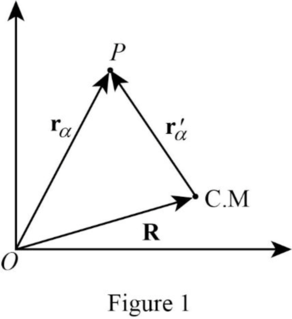
(a)
Sketch a diagram to illustrate the equation
(a)
Answer to Problem 3.37P
Figure
Explanation of Solution
Consider a system of

Figure
In figure
Use figure
Use equation (I) to solve for
Conclusion:
Therefore, figure
(b)
Prove the relation
(b)
Answer to Problem 3.37P
It is proved that the relation
Explanation of Solution
Write the expression for the sum of moment of masses about the center of mass.
Write the expression for the position of the center of mass of
Write the expression for the mass of all the particles in the system.
Use equation (IV) and (V) in (III) to solve for the sum of moment of masses about the center of mass.
The sum
Conclusion:
Therefore, it is proved that the relation
(c)
Prove the rate of change of the
(c)
Answer to Problem 3.37P
It is proved that the rate of change of the angular momentum about the center of mass is equal to the total external torque about the center of mass.
Explanation of Solution
Write the expression for the angular momentum of the system about the center of mass.
Here,
Write the expression for momentum.
Here,
Use equation (VIII) in (VII) to solve for
Differentiate equate (IX) with respect to time on both sides,
Take the
Use equation (XI) in (X) to solve for
Write the expression for the external force acting on a mass
Here,
Write the expression for the torque acting on mass
Write the expression for
Use equation (XV), (XIV) and (XIII) in (XII) to solve for
Sum of external torque acting on each mass of the system is equal to the external torque acting on the system about its center of mass.
Here,
Conclusion:
Therefore, it is proved that the rate of change of the angular momentum about the center of mass is equal to the total external torque about the center of mass.
Want to see more full solutions like this?
Chapter 3 Solutions
Classical Mechanics
- 5 Find the total work done by forces A and B if the object undergoes the displacement C. Hint: Can you add the two forces first?arrow_forward1 F2 F₁ -F₁ F6 F₂ S A Work done on the particle as it moves through the displacement is positive. True False by the force Farrow_forwardA student measuring the wavelength produced by a vapour lamp directed the lightthrough two slits with a separation of 0.20 mm. An interference pattern was created on the screen,3.00 m away. The student found that the distance between the first and the eighth consecutive darklines was 8.0 cm. Draw a quick picture of the setup. What was the wavelength of the light emittedby the vapour lamp?arrow_forward
- A ball is tied to one end of a string. The other end of the string is fixed. The ball is set in motion around a vertical circle without friction. At the top of the circle, the ball has a speed of ; = √√ Rg, as shown in the figure. At what angle should the string be cut so that the ball will travel through the center of the circle? The path after string is cut Rarrow_forward(a) A luggage carousel at an airport has the form of a section of a large cone, steadily rotating about its vertical axis. Its metallic surface slopes downward toward the outside, making an angle of 24.5° with the horizontal. A 30.0-kg piece of luggage is placed on the carousel, 7.46 m from the axis of rotation. The travel bag goes around once in 37.5 s. Calculate the magnitude of the force of static friction between the bag and the carousel. Your response differs significantly from the correct answer. Rework your solution from the beginning and check each step carefully. N (b) The drive motor is shifted to turn the carousel at a higher constant rate of rotation, and the piece of luggage is bumped to a position 7.94 m from the axis of rotation. The bag is on the verge of slipping as it goes around once every 30.5 s. Calculate the coefficient of static friction between the bag and the carousel. Your response differs significantly from the correct answer. Rework your solution from the…arrow_forward(a) Imagine that a space probe could be fired as a projectile from the Earth's surface with an initial speed of 5.78 x 104 m/s relative to the Sun. What would its speed be when it is very far from the Earth (in m/s)? Ignore atmospheric friction, the effects of other planets, and the rotation of the Earth. (Consider the mass of the Sun in your calculations.) Your response is within 10% of the correct value. This may be due to roundoff error, or you could have a mistake in your calculation. Carry out all intermediate results to at least four-digit accuracy to minimize roundoff error. m/s (b) What If? The speed provided in part (a) is very difficult to achieve technologically. Often, Jupiter is used as a "gravitational slingshot" to increase the speed of a probe to the escape speed from the solar system, which is 1.85 x 104 m/s from a point on Jupiter's orbit around the Sun (if Jupiter is not nearby). If the probe is launched from the Earth's surface at a speed of 4.10 x 10 m/s relative…arrow_forward
- As shown in the figure, a roller-coaster track includes a circular loop of radius R in a vertical plane. A car of mass m is released from rest at a height h above the bottom of the circular section and then moves freely along the track with negligible energy loss due to friction. i (a) First suppose the car barely makes it around the loop; at the top of the loop, the riders are upside down and feel weightless. Find the required height h of the release point above the bottom of the loop. (Use any variable or symbol stated above along with the following as necessary: g.) h = (b) If the car is released at some point above the minimum required height, determine the amount by which the normal force on the car at the bottom of the loop exceeds the normal force on the car at the top of the loop. (Consider the moments when the car reaches the top and when it reaches the bottom again. Use any variable or symbol stated above along with the following as necessary: g.) NB - NT = The normal force…arrow_forwardOne of the more challenging elements in pairs figure skating competition is the "death spiral" (see the figure below), in which the female figure skater, balanced on one skate, is spun in a circle by the male skater. i The axis of rotation of the pair is vertical and through the toe of the skate on the male skater's leg that is bent backward, the toe being planted into the ice. During the one-armed maneuver first developed in the 1940s, the outstretched arm of the male skater must apply a large force to support a significant fraction of the female skater's weight and also to provide her centripetal acceleration. This force represents a danger to the structure of the wrist of the male skater. (a) Modeling the female skater, of mass 47.0 kg, as a particle, and assuming that the combined length of the two outstretched arms is 129 cm and that arms make an angle of 45.0° with the horizontal, what is the magnitude of the force (in N) exerted by the male skater's wrist if each turn is…arrow_forwardOne popular design of a household juice machine is a conical, perforated stainless steel basket 3.30 cm high with a closed bottom of diameter 8.00 cm and open top of diameter 14.40 cm that spins at 16000 revolutions per minute about a vertical axis. Solid pieces of fruit are chopped into granules by cutters at the bottom of the spinning cone. Then the fruit granules rapidly make their way to the sloping surface where the juice is extracted to the outside of the cone through the mesh perforations. The dry pulp spirals upward along the slope to be ejected from the top of the cone. The juice is collected in an enclosure immediately surrounding the sloped surface of the cone. Pulp Motor Spinning basket Juice spout (a) What centripetal acceleration does a bit of fruit experience when it is spinning with the basket at a point midway between the top and bottom? m/s² ---Direction--- (b) Observe that the weight of the fruit is a negligible force. What is the normal force on 2.00 g of fruit at…arrow_forward
- A satellite is in a circular orbit around the Earth at an altitude of 3.88 × 106 m. (a) Find the period of the orbit. (Hint: Modify Kepler's third law so it is suitable for objects orbiting the Earth rather than the Sun. The radius of the Earth is 6.38 × 106 m, and the mass of the Earth is 5.98 x 1024 kg.) h (b) Find the speed of the satellite. km/s (c) Find the acceleration of the satellite. m/s² toward the center of the eartharrow_forwardShown below is a waterslide constructed in the late 1800's. This slide was unique for its time due to the fact that a large number of small wheels along its length made friction negligible. Riders rode a small sled down the chute which ended with a horizontal section that caused the sled and rider to skim across the water much like a flat pebble. The chute was 9.76 m high at the top and 54.3 m long. Consider a rider and sled with a combined mass of 81.0 kg. They are pushed off the top of the slide from point A with a speed of 2.90 m/s, and they skim horizontally across the water a distance of 50 m before coming to rest. 9.76 m Engraving from Scientific American, July 1888 A (a) 20.0 m/ -54.3 m- 50.0 m (b) (a) Find the speed (in m/s) of the sled and rider at point C. 14.14 m/s (b) Model the force of water friction as a constant retarding force acting on a particle. Find the magnitude (in N) of the friction force the water exerts on the sled. 162.2 N (c) Find the magnitude (in N) of the…arrow_forwardA small object with mass 3.60 kg moves counterclockwise with constant angular speed 1.40 rad/s in a circle of radius 2.55 m centered at the origin. It starts at the point with position vector 2.551 m. Then it undergoes an angular displacement of 9.15 rad. (a) What is its new position vector? m (b) In what quadrant is the object located and what angle does its position vector make with the positive x-axis? ---Select--- ✓ at (c) What is its velocity? m/s (d) In what direction is it moving? (Give a negative angle.) ° from the +x direction. (e) What is its acceleration? m/s² (f) What total force is exerted on the object? Narrow_forward
 College PhysicsPhysicsISBN:9781305952300Author:Raymond A. Serway, Chris VuillePublisher:Cengage Learning
College PhysicsPhysicsISBN:9781305952300Author:Raymond A. Serway, Chris VuillePublisher:Cengage Learning University Physics (14th Edition)PhysicsISBN:9780133969290Author:Hugh D. Young, Roger A. FreedmanPublisher:PEARSON
University Physics (14th Edition)PhysicsISBN:9780133969290Author:Hugh D. Young, Roger A. FreedmanPublisher:PEARSON Introduction To Quantum MechanicsPhysicsISBN:9781107189638Author:Griffiths, David J., Schroeter, Darrell F.Publisher:Cambridge University Press
Introduction To Quantum MechanicsPhysicsISBN:9781107189638Author:Griffiths, David J., Schroeter, Darrell F.Publisher:Cambridge University Press Physics for Scientists and EngineersPhysicsISBN:9781337553278Author:Raymond A. Serway, John W. JewettPublisher:Cengage Learning
Physics for Scientists and EngineersPhysicsISBN:9781337553278Author:Raymond A. Serway, John W. JewettPublisher:Cengage Learning Lecture- Tutorials for Introductory AstronomyPhysicsISBN:9780321820464Author:Edward E. Prather, Tim P. Slater, Jeff P. Adams, Gina BrissendenPublisher:Addison-Wesley
Lecture- Tutorials for Introductory AstronomyPhysicsISBN:9780321820464Author:Edward E. Prather, Tim P. Slater, Jeff P. Adams, Gina BrissendenPublisher:Addison-Wesley College Physics: A Strategic Approach (4th Editio...PhysicsISBN:9780134609034Author:Randall D. Knight (Professor Emeritus), Brian Jones, Stuart FieldPublisher:PEARSON
College Physics: A Strategic Approach (4th Editio...PhysicsISBN:9780134609034Author:Randall D. Knight (Professor Emeritus), Brian Jones, Stuart FieldPublisher:PEARSON





